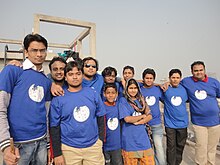WikiWomenCamp/FAQ/Perspectives/Bangladesh
 Bangladesh[edit]
Bangladesh[edit]


The official language of Bangladesh is Bengali.
- The Chapter and offline participation
During Wikimedia Bangladesh event, there are female participants who attend every meet-up. Most of the time, these are new faces and there is a problem in getting the same women to consistently show up to events in order to build up a regular base of active female participants. Currently Wikimedia Bangladesh has no female members in the board. The board is planning to find a woman from the country to be a a Bengali participant in at WikiWomenCamp in Argentina.
- Wikipedia
The projects have very few female contributors. Those who contribute stated that hey do have do not have time to contribute on a consistent, regular basis; they edit sporadically. Bengali Wikipedia rank 67 out of 280 wikipedia language project. There are around 6 very active editors (more than 100 edits per month) and 50 active editor (more than 5 edits per month)
In December 2011, there were 1,700 women of all ages from Bangladesh who were interested in Wikipedia on Facebook.[1] 0.06% of all Wikipedia traffic comes from Bangladesh.[2] Most editors in Bangladesh edit the Bengali Wikipedia but 91.1% view English Wikipedia. There are many articles about Bengali actresses on the Bengali Wikipedia. These articles were mostly created by male contributors. There is an effort by a Bengali editor to take the Bengali language article about Angelina Jolie to Featured. As of December 2011, there are zero featured articles about women on Bengali Wikipedia. There are two articles about female sport people: an athlete and a chess player. There are 10 articles about female film actresses from Bangladesh, 10 articles about female television actresses from Bangladesh, 3 articles about female Bangladeshi stage actresses and 13 articles about Bangladeshi singers. On Bengali Wikipedia, there are 4 articles about Bangladeshi social workers, 3 of whom women. The amount of women specific content in Bengali, and Bangaldeshi women content, is limited. The Bengali word for User is gender neutral; the name space does not indicate the gender of the user on Wikimedia projects.
On English Wikipedia, there are 11 articles women in politics, 4 articles about Bangladeshi feminists. Bangladeshi women do not appear to be given much coverage on non-Bengali Wikipedia. This is for several reasons, including a lack of participation of women in certain categories, language issues that make it difficult to report on Bangladeshi women, and a general lack of interest in existing contributors in covering their issues.

In December 2011, according to Alexa, Wikinews was ranked the 17,538th most popular site in the country.[3].On December 2011 search on English Wikinews for Women Bangladesh found 5 articles that mentioned both words.[4]
Bangladeshi women are absent on other projects connected to the Wikimedia Foundation. There is one woman who has contributed to the language incubator who uses Bengali. She made one edit and is the only Bengali speaker to make an edit on incubator.
- Bangladesh women perspective to free knowledge
Unknown
- Women in Bangladesh
Available data on health, nutrition, education, and economic performance indicated that in the 1980s the status of women in Bangladesh remained considerably inferior to men. Women, in custom and practice, remained subordinate to men in almost all aspects of their lives; greater autonomy was the privilege of the rich or the necessity of the very poor. Most women's lives remained centered on their traditional roles, and they had limited access to markets, productive services, education, health care, and local government. This lack of opportunities contributed to high fertility patterns there are views that acute poverty at the margin appeared to be hitting hardest at women. About 82 percent of women lived in rural areas in the late 1980s. The majority of rural women, perhaps 70 percent, were in small cultivator, tenant, and landless households; many worked as laborers part time or seasonally, usually in post-harvest activities, and received payment in kind or in meager cash wages. The economic contribution of women was substantial but largely unacknowledged. Women in rural areas were responsible for most of the post-harvest work, which was done in the chula, and for keeping livestock, poultry, and small gardens. Women in cities relied on domestic and traditional jobs, but in the 1980s they increasingly worked in manufacturing jobs, especially in the readymade garment industry. Those with more education worked in government, health care, and teaching, but their numbers remained very small. Continuing high rates of population growth and the declining availability of work based in the chula meant that more women sought employment outside the home. Female wage rates in the 1980s were low, typically ranging between 20 and 30 percent of male wage rates.
- The Foundation
Bangladeshi women also do not appear to factor into the WMF's wider strategy to appeal to the region: During the December 2011 fundraising appeal, no Bangladeshis, men or women, were featured are part of the appeal. During the 2011 Summer of Research, the WMF hired eight research fellows. Of these, only one was female, and she was from the United States. There were four males from American universities, The other researchers included men from a Japanese university, a Swiss university and a Canadian university. There were no research fellows, male or female, from this country.
